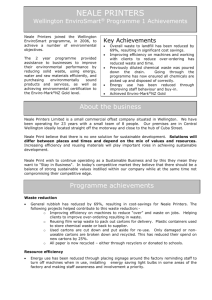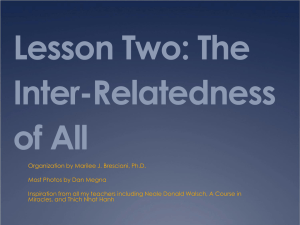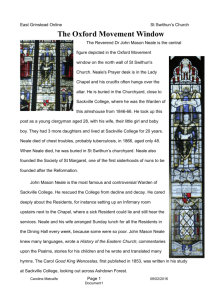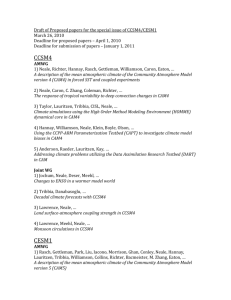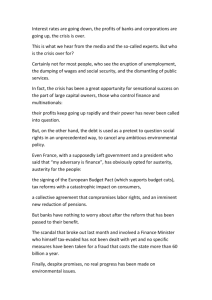What`s Wrong with America
advertisement
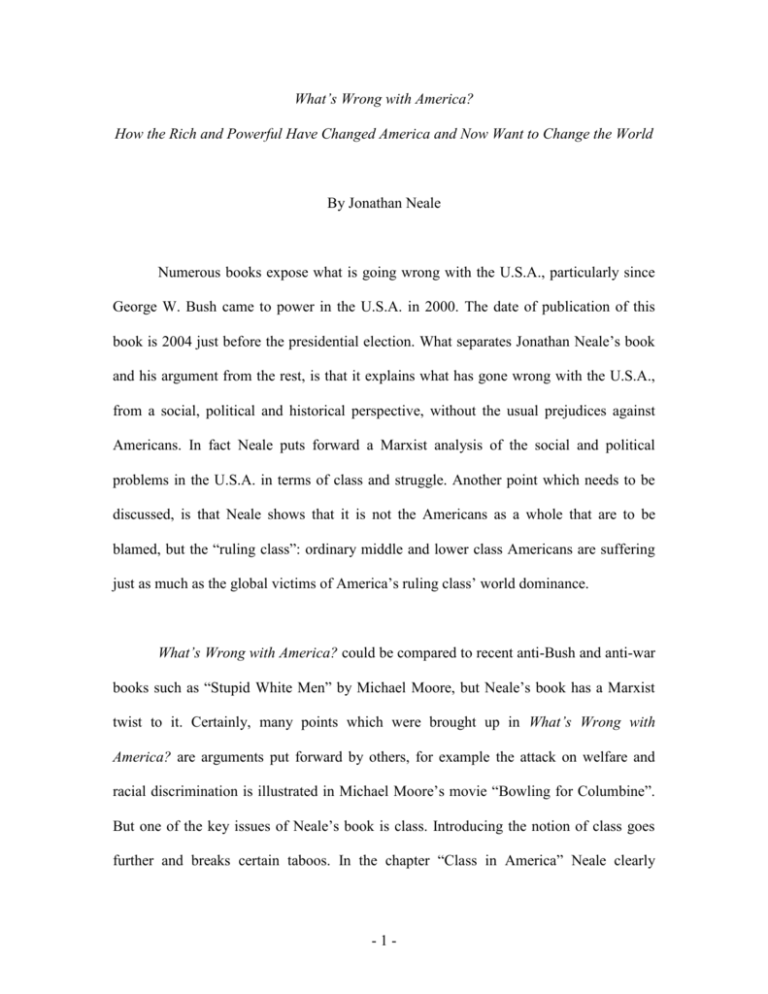
What’s Wrong with America? How the Rich and Powerful Have Changed America and Now Want to Change the World By Jonathan Neale Numerous books expose what is going wrong with the U.S.A., particularly since George W. Bush came to power in the U.S.A. in 2000. The date of publication of this book is 2004 just before the presidential election. What separates Jonathan Neale’s book and his argument from the rest, is that it explains what has gone wrong with the U.S.A., from a social, political and historical perspective, without the usual prejudices against Americans. In fact Neale puts forward a Marxist analysis of the social and political problems in the U.S.A. in terms of class and struggle. Another point which needs to be discussed, is that Neale shows that it is not the Americans as a whole that are to be blamed, but the “ruling class”: ordinary middle and lower class Americans are suffering just as much as the global victims of America’s ruling class’ world dominance. What’s Wrong with America? could be compared to recent anti-Bush and anti-war books such as “Stupid White Men” by Michael Moore, but Neale’s book has a Marxist twist to it. Certainly, many points which were brought up in What’s Wrong with America? are arguments put forward by others, for example the attack on welfare and racial discrimination is illustrated in Michael Moore’s movie “Bowling for Columbine”. But one of the key issues of Neale’s book is class. Introducing the notion of class goes further and breaks certain taboos. In the chapter “Class in America” Neale clearly -1- identifies the ruling class and the working class of America. According to him around 80% of Americans could be counted as working class. His definition of working class basically contains those who are told what they have to do at work, which can be bluecollar workers and service workers. This seems very plausible, since it doesn’t really matter if you are working on an assembly line making cars or if you are flipping burgers at McDonalds: you are not in charge. Furthermore, Neale shows the socio-economic changes that America has undergone since the 1960s. In his view, since the 1960s profits had been falling during numerous recessions. The problem is that if profits of businesses drop, as a consequence their competitiveness drops and they have to close. So the response of government and corporate elites was to reduce taxes on businesses, cut the welfare state, break unions, hold down wages, tear up environmental regulations and privatize anything that moved. In order to do this, resistance had to be broken. From the author’s point of view all American governments, be it Republican or Democrat did this from the 1980’s on. Neale portraits the attack on the American working class in an eye opening manner, the reader understands very quickly what injustices have been done to working class Americans. Neale secondly argues that the resistance against the ambitions of the ruling class has been broken progressively over the past twenty years. This resistance was encountered in the form of civil rights movements, anti-war movements, unions and women’s as well as gay liberation movements. The struggle of these various groups in the past and today is another key issue in Neale’s book. This struggle is depicted in a brief history of fights and protests led by various social movements such as civil rights -2- movements in the 1960’s, women’s liberation movements, gay liberation movements and anti-war movements but also unions. However, over the past twenty years all these movements have known great defeats. Their resistance was broken by giving AfricanAmericans and women a place at the bottom of the ruling class on one hand, and on the other by brutally repressing unions, imprisoning large parts of the African-American population, discrediting women’s and gay liberation movements, and by implanting the idea in people’s heads that they were to be blamed for everything that went wrong in their lives and in society. On a world scale, the ruling class managed to break socialist and nationalist resistance by using their economic and military power. So to answer the question of what is wrong with the U.S.A. Neale seems to argue that it is the people’s progressive loss of power to the ruling class. This loss triggered reactions like strikes, protests and riots, such as the protests of the anti-capitalist movement in Seattle in 1999. Towards the end of his book the author argues that resistance is forming again. In fact Neale seems to celebrate new waves of protest against the U.S.A. and globalization. He also argues that the Seattle protests were a victory for the anti-globalization movement. While it is true that people from many movements came together to protest in Seattle and that no agreements were signed, one could argue that globalization in terms of westernization and global domination of western powers has not stopped at all. The change that anti-globalization movements have achieved could be seen as “cosmetic”. 1 Likewise from a pessimistic point of view one could ask, what changes did any protests result in since the 1960’s? Have there been any revolutionary changes? Certainly there was a certain impact on society, but the problems of the pre-1968 era still remain 1 David Held and Anthony McGrew Globalization/Anti-Globalization (Cambridge, U.K. : Polity ; Malden, MA : Blackwell Publishers, 2002) p.64-65 -3- unchanged. For example the economic situation of African-Americans in the U.S.A. has stagnated and even declined since the civil rights movement.2 The world order remained the same and the relation between classes, which is depicted in this book, remained the same as well. Neale also cites the example of recent protests in many European cities during 2003. Millions of people demonstrated against the war in Iraq and the governments of Germany and France refused to participate in the war. Neale says that there was a “threat to American dominance”. This might be true, but the war still took place, however many protests there were. Jonathan Neale successfully points out various problems that many people would agree with, but one would like to know what alternatives there are to the situation that is depicted. In conclusion Jonathan Neale’s book is very original in regard of the huge amount of books there are about the U.S.A. He clearly makes it possible to understand America’s problems, without the usual stereotypes of a rich conservative America that is united in trying to dominate the world. Here it is clearly said that working class Americans suffer just as much as any working class person in the world. The political and socio-economic analysis of the U.S.A. helps to gain a better perspective of what has really gone wrong. At the end of the book the author welcomes protests against the U.S.A. and globalization, but one could argue that they haven’t brought about much change. Lewis M. Killian ‘Race Relations and the Nineties: Where are the Dreams of the Sixties?’ Social Forces, Vol.69, No. 1 (Sep., 1990) p.6-7 2 -4- Bibliography 1. Held, David and McGrew, Anthony Globalization/Anti-Globalization (Cambridge, U.K. : Polity ; Malden, MA : Blackwell Publishers, 2002) p.64-65 2. Killian, Lewis M. ‘Race Relations and the Nineties: Where are the Dreams of the Sixties?’ Social Forces, Vol.69, No. 1 (Sep., 1990) p.6-7 -5-
